Themed collection 2016 New talent

2016 New talent: crystal engineering at its biggest and strongest
Welcome to the 2016 New talent issue of CrystEngComm.

CrystEngComm, 2016,18, 3963-3967
https://doi.org/10.1039/C6CE90060G
Inorganic and organic hybrid solid electrolytes for lithium-ion batteries
Two inorganic–organic hybrid solid electrolyte systems for lithium-ion batteries are described: polymer electrolytes with inorganic fillers and metal–organic framework-based solid electrolytes.
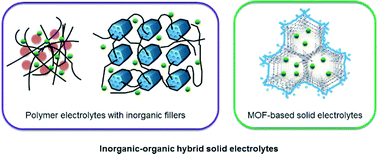
CrystEngComm, 2016,18, 4236-4258
https://doi.org/10.1039/C6CE00171H
Smart, stretchable and wearable supercapacitors: prospects and challenges
Flexible supercapacitors are attracting increasing attention due to their promising applications as storage units in smart and portable electronic devices.
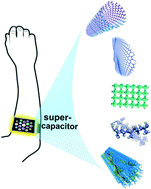
CrystEngComm, 2016,18, 4218-4235
https://doi.org/10.1039/C5CE02510A
All-thiolate-protected silver and silver-rich alloy nanoclusters with atomic precision: stable sizes, structural characterization and optical properties
The stable sizes, structural characterization and optical properties of all-thiolate-protected silver and silver-rich alloy nanoclusters with atomic precision are highlighted.
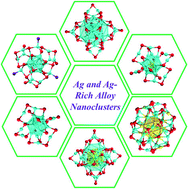
CrystEngComm, 2016,18, 3996-4005
https://doi.org/10.1039/C5CE02494C
Photoswitchable metal organic frameworks: turn on the lights and close the windows
Progress and challenges in the development of photo-responsive metal organic frameworks.
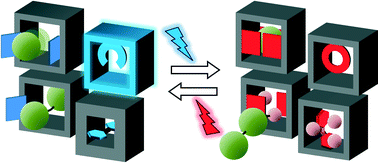
CrystEngComm, 2016,18, 4006-4012
https://doi.org/10.1039/C5CE02543E
Metal–organic frameworks (MOFs) bring new life to hydrogen-bonding organocatalysts in confined spaces
Immobilization of hydrogen-bonding organocatalysts on metal–organic frameworks (MOFs) provides a promising alternative to overcome the self-quenching limitations of these catalysts.
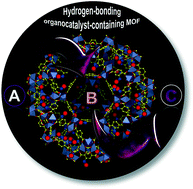
CrystEngComm, 2016,18, 3985-3995
https://doi.org/10.1039/C5CE02526E
2D layered group IIIA metal chalcogenides: synthesis, properties and applications in electronics and optoelectronics
Two-dimensional group IIIA metal chalcogenides have promising potential in applications such as nano-electronics and optoelectronics as well as flexible devices.
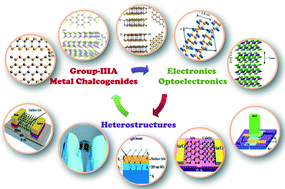
CrystEngComm, 2016,18, 3968-3984
https://doi.org/10.1039/C5CE01986A
On the predictability of supramolecular interactions in molecular cocrystals – the view from the bench
A series of cocrystals involving theophylline and fluorobenzoic acids highlights the difficulty of predicting supramolecular interactions in molecular crystals.
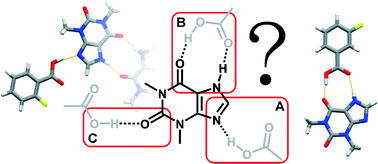
CrystEngComm, 2016,18, 5434-5439
https://doi.org/10.1039/C6CE00293E
Anion-templated 2D frameworks from hexahydroxytriphenylene
Hexahydroxytriphenylene (HHTP) forms novel anion templated materials through O–H⋯anion hydrogen bonding.
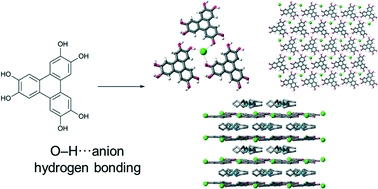
CrystEngComm, 2016,18, 4281-4284
https://doi.org/10.1039/C6CE00297H
C–C coupling over Schiff base condensation: a rational design strategy for a strongly fluorescent molecular material
Two aesthetically appealing molecules were synthesized employing pyrido[1,2-a]indole and tetraphenylethylene. The C–C coupled product showed strong emission in solution, nanoparticles and solid state compared to the weak emission exhibited by the Schiff base condensation product.
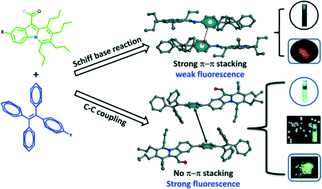
CrystEngComm, 2016,18, 4290-4294
https://doi.org/10.1039/C5CE02489G
Supramolecular ordering of difuryldiketopyrrolopyrrole: the effect of alkyl chains and inter-ring twisting
Combined XRD, STM and DFT studies reveal the details of supramolecular ordering of difuryldiketopyrrolopyrrole in monolayers and 3D crystals.
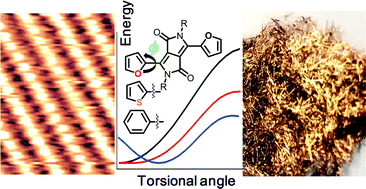
CrystEngComm, 2016,18, 4285-4289
https://doi.org/10.1039/C6CE00383D
Homochiral crystal generation via sequential dehydration and Viedma ripening
Asymmetric amplification of conglomerate crystals formed via the dehydration of initially achiral crystals was achieved using Viedma ripening.
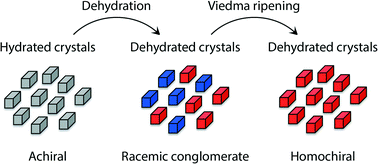
CrystEngComm, 2016,18, 4277-4280
https://doi.org/10.1039/C6CE00119J
An organic–inorganic hybrid supramolecular framework material based on a [P2W18O62]6− cluster and Yb & Na complexes of pyridine-2,6-dicarboxylic acid: a catalyst for selective oxidation of sulfides in water with H2O2
Synthesis and green catalytic activity of a Yb-contained polyoxometalate organic hybrid framework is described.
![Graphical abstract: An organic–inorganic hybrid supramolecular framework material based on a [P2W18O62]6− cluster and Yb & Na complexes of pyridine-2,6-dicarboxylic acid: a catalyst for selective oxidation of sulfides in water with H2O2](/en/Image/Get?imageInfo.ImageType=GA&imageInfo.ImageIdentifier.ManuscriptID=C5CE02546J&imageInfo.ImageIdentifier.Year=2016)
CrystEngComm, 2016,18, 4272-4276
https://doi.org/10.1039/C5CE02546J
A new azodioxy-linked porphyrin-based semiconductive covalent organic framework with I2 doping-enhanced photoconductivity
A homogeneous solution phase reaction was employed to synthesize an azodioxy-linked porphyrin-based semiconductive covalent organic framework (COF), namely POR-COF. The iodine-doped POR-COF shows a significantly enhanced photoconductive behavior.
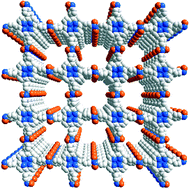
CrystEngComm, 2016,18, 4259-4263
https://doi.org/10.1039/C6CE00168H
Amino acids as biomimetic crystallization agents for the synthesis of ZIF-8 particles
Biomimetic mineralization of metal–organic frameworks (MOFs) exploits the use of biomolecules to control MOF crystallization processes.

CrystEngComm, 2016,18, 4264-4267
https://doi.org/10.1039/C5CE02549D
A lanthanide(III) metal–organic framework exhibiting ratiometric luminescent temperature sensing and tunable white light emission
New lanthanide(III) metal–organic frameworks are constructed and exhibit a good linear relationship with respect to the temperature range of 75–250 K. White light emission can be realized by varying the excitation wavelength of Eu0.0748Tb0.9252L.
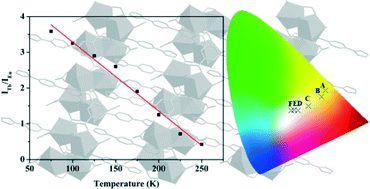
CrystEngComm, 2016,18, 4268-4271
https://doi.org/10.1039/C5CE02444G
Facile synthesis of an organically-derivatized hexavanadate containing the remote amino group, TBA2[V6O13{(OCH2)3CNH2}2]
An effective synthetic strategy for the amino-containing organic derivative of hexavanadate, TBA2[V6O13{(OCH2)3CNH2}2], is presented.
![Graphical abstract: Facile synthesis of an organically-derivatized hexavanadate containing the remote amino group, TBA2[V6O13{(OCH2)3CNH2}2]](/en/Image/Get?imageInfo.ImageType=GA&imageInfo.ImageIdentifier.ManuscriptID=C5CE02534F&imageInfo.ImageIdentifier.Year=2016)
CrystEngComm, 2016,18, 4042-4045
https://doi.org/10.1039/C5CE02534F
Templating synthesis of ternary PtPdTe nanowires with tunable diameter for methanol electrooxidation
PtPdTe ternary nanowires with controllable diameter can be constructed using tellurium nanowires as templates for methanol electrooxidation.

CrystEngComm, 2016,18, 4038-4041
https://doi.org/10.1039/C5CE02551F
Luminescent nanoprobes based on upconversion nanoparticles and single-walled carbon nanohorns or graphene oxide for detection of Pb2+ ion
Two kinds of luminescent “turn-on” nanoprobes were developed for detecting Pb2+ ions based on luminescence resonance energy transfer between upconversion nanoparticles and single-walled carbon nanohorns or graphene oxide.
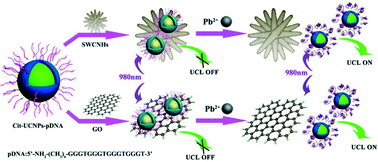
CrystEngComm, 2016,18, 4032-4037
https://doi.org/10.1039/C5CE02537K
A facile strategy for the synthesis of branched Pt–Pd–M (M = Co, Ni) trimetallic nanocrystals
Pt-based branched nanocrystals (NCs) have attracted much attention because of their unique properties.
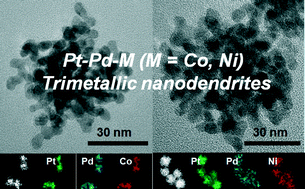
CrystEngComm, 2016,18, 4023-4026
https://doi.org/10.1039/C5CE02478A
Control of interpenetration of copper-based MOFs on supported surfaces by electrochemical synthesis
A study of a copper-based metal–organic framework (MOF) synthesized by an electrochemical route is presented.
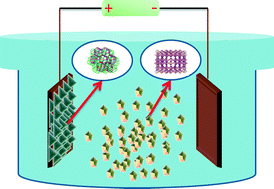
CrystEngComm, 2016,18, 4018-4022
https://doi.org/10.1039/C5CE02462E
Graphene oxide-templated preferential growth of continuous MOF thin films
A graphene oxide film was used as an interfacial template for the preferential growth of continuous HKUST-1 films on a solid substrate.
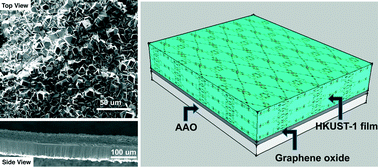
CrystEngComm, 2016,18, 4013-4017
https://doi.org/10.1039/C5CE02188J
Janus head type lone pair–π–lone pair and S⋯F⋯S interactions in retaining hexafluorobenzene
Unprecedented Janus head type lp⋯π⋯lp and S⋯F⋯S motifs were observed between tris-arylthiotriazine and hexafluorobenzene.

CrystEngComm, 2016,18, 4438-4444
https://doi.org/10.1039/C6CE00496B
On the electrochemical encounter between sodium and mesoporous anatase TiO2 as a Na-ion electrode
Mesoporous anatase titanium dioxide (TiO2) is prepared by an easily up-scalable synthesis protocol, using relatively inexpensive precursors. Operando electrochemical X-ray diffraction and Raman studies of TiO2/Na half-cells are presented and discussed.

CrystEngComm, 2016,18, 4431-4437
https://doi.org/10.1039/C5CE02598B
Two solvent-stable MOFs as a recyclable luminescent probe for detecting dichromate or chromate anions
Two unique 2D Zn-MOFs with high thermo-stability, solvent-stability and pH-stability can efficiently and selectively detect Cr2O72−/CrO42− among twenty-one anions. Importantly, they can be regenerated by a simple and rapid method in detecting Cr2O72−/CrO42−.
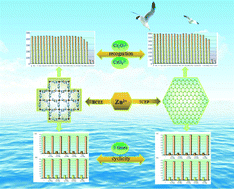
CrystEngComm, 2016,18, 4445-4451
https://doi.org/10.1039/C5CE02568K
Energy barriers and mechanisms in solid–solid polymorphic transitions exhibiting cooperative motion
The cooperative behaviour at the molecular scale of the β → α polymorphic transition of DL-norleucine is studied with different computational approaches.
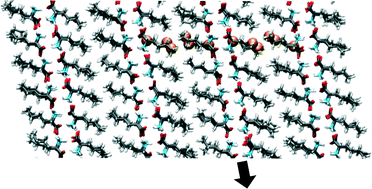
CrystEngComm, 2016,18, 4420-4430
https://doi.org/10.1039/C5CE02550H
Synthesis of microporous/mesoporous core–shell materials with crystalline zeolitic shell and supported metal oxide silica core
Engineered silica@zeolite core–shell composites, possessing a hierarchical porosity in a shape selective manner, were synthesised by deposition of silicalite-1 nanocrystals over various mesoporous silica spheres, in either pure form or loaded with metal guest species.
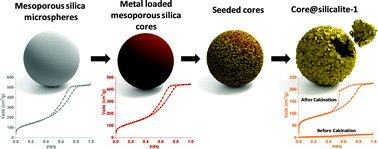
CrystEngComm, 2016,18, 4452-4464
https://doi.org/10.1039/C6CE00286B
Selective CO2 adsorption in four zinc(II)-based metal organic frameworks constructed using a rigid N,N′-donor linker and various dicarboxylate ligands
Four new Zn(II)-based metal organic frameworks have been synthesized and their adsorption abilities explored towards selective CO2 capture at different temperatures.
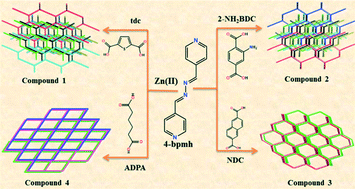
CrystEngComm, 2016,18, 4395-4404
https://doi.org/10.1039/C5CE02542G
Serpentine polymorphism: a quantitative insight from first-principles calculations
Ab initio calculations measure strain energy, curling and lattice misfit of single-walled chrysotile nanotubes.
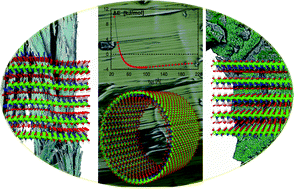
CrystEngComm, 2016,18, 4412-4419
https://doi.org/10.1039/C6CE00190D
A self-powered photodetector based on a CH3NH3PbI3 single crystal with asymmetric electrodes
By employing asymmetric Au–Al electrodes, we reported a self-powered Schottky junction photodetector based on a MAPbI3 single crystal.
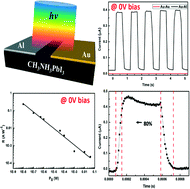
CrystEngComm, 2016,18, 4405-4411
https://doi.org/10.1039/C5CE02531A
A series of dinuclear cuprous iodide complexes chelated with 1,2-bis(diphenylphosphino)benzene derivatives: structural, photophysical and thermal properties
Three new bisphosphine ligands, Ph-dppd, Pr-dppb, and OMe-dppb, were synthesized to coordinate with cuprous iodide (CuI), and compared with dppb.
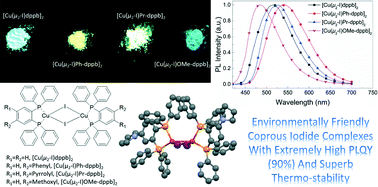
CrystEngComm, 2016,18, 4388-4394
https://doi.org/10.1039/C5CE02533H
From benzodithiophene to diethoxy-benzodithiophene covalent organic frameworks – structural investigations
The incorporation of side groups into a covalent organic framework (COF) backbone can be of significant importance for developing new frameworks with enhanced properties.
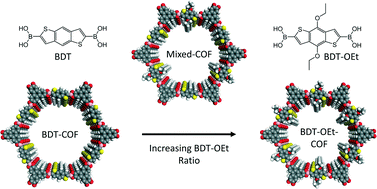
CrystEngComm, 2016,18, 4295-4302
https://doi.org/10.1039/C6CE00193A
Cerium-based azide- and nitro-functionalized UiO-66 frameworks as turn-on fluorescent probes for the sensing of hydrogen sulphide
Cerium-based azide- and nitro-functionalized UiO-66 MOFs have been employed as turn-on fluorescent probes towards the detection of H2S under physiological conditions.
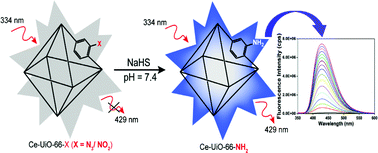
CrystEngComm, 2016,18, 4374-4381
https://doi.org/10.1039/C6CE00032K
Synthesis and optoelectronic properties of oxadiazole coordinated boron complexes
Two novel boron complexes were synthesized and investigated. And these two complexes showed their potential application in organic light-emitting diodes because of their deep blue emitting and excellent electron transporting properties.
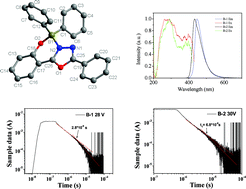
CrystEngComm, 2016,18, 4382-4387
https://doi.org/10.1039/C6CE00066E
Rods, helices and spherulites: diverse self-assembled architectures from L-phenylalanine derivatives
L-Phenylalanine derivatives produce a variety of self-assembled architectures, and a doxorubicin entrapping hydrogel.
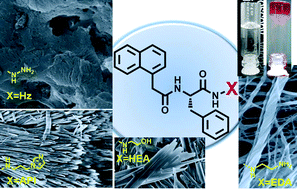
CrystEngComm, 2016,18, 4369-4373
https://doi.org/10.1039/C5CE02545A
Exploration of MOF nanoparticle sizes using various physical characterization methods – is what you measure what you get?
To shed light on the concept of nanoparticle size, spherical Zr-fum MOF nanoparticles were studied using various complementary size-determination tools.
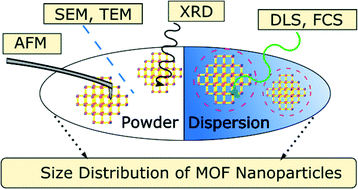
CrystEngComm, 2016,18, 4359-4368
https://doi.org/10.1039/C6CE00198J
Two- and three-dimensional Zn(II) coordination polymers constructed from mixed ligand systems: interpenetration, structural transformation and sensing behavior
Four Zn(II) coordination compounds were prepared solvothermally by reacting Zn2+ ion and mixed organic linkers.
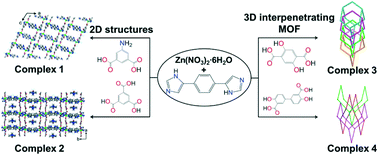
CrystEngComm, 2016,18, 4349-4358
https://doi.org/10.1039/C6CE00155F
Photosensitized samarium(III) and erbium(III) complexes of planar N,N-donor heterocyclic bases: crystal structures and evaluation of biological activity
A series of Sm(III) and Er(III) complexes of N,N-donor heterocyclic bases were studied for their crystal structures, luminescence properties, binding with biomolecules and photo-induced DNA damage activity.

CrystEngComm, 2016,18, 4313-4322
https://doi.org/10.1039/C5CE02387D
A facile biliquid-interface co-assembly synthesis of mesoporous vesicles with large pore sizes
A facile and cost-efficient biliquid-interface co-assembly method has been demonstrated for the synthesis of novel mesoporous siliceous vesicles with an ultrathin wall, large void, large pore size and excellent biocompatibility using cetyltrimethylammonium bromide as the template.
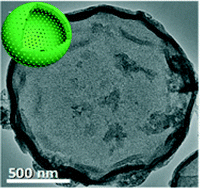
CrystEngComm, 2016,18, 4343-4348
https://doi.org/10.1039/C5CE02592C
Synthesis, structures and luminescence properties of 3d–4f heterometallic–organic frameworks (HMOFs) constructed from different copper halide clusters
Four 3d–4f heterometallic–organic frameworks (HMOFs) constructed from different copper halide clusters display interesting structural features.

CrystEngComm, 2016,18, 4336-4342
https://doi.org/10.1039/C5CE02544C
Structural variation of transition metal coordination polymers based on bent carboxylate and flexible spacer ligand: polymorphism, gas adsorption and SC-SC transmetallation
Seven new coordination polymers have been synthesized and characterized by EA, IR, TGA, PXRD and SC-XRD. Polymorphism, SC-SC transmetallation and gas sorption properties have been studied.
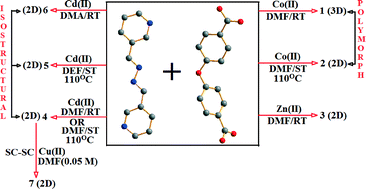
CrystEngComm, 2016,18, 4323-4335
https://doi.org/10.1039/C6CE00151C
Discovering connections between terahertz vibrations and elasticity underpinning the collective dynamics of the HKUST-1 metal–organic framework
We employed a combination of theoretical and experimental techniques to study the metal–organic framework (MOF)-mechanics central to the paddle-wheel Cu3(BTC)2 porous structure, commonly designated as HKUST-1.
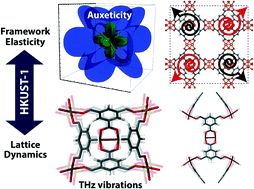
CrystEngComm, 2016,18, 4303-4312
https://doi.org/10.1039/C5CE02347E
Raising the (metastable) bar: 100% photo-switching in [Pd(Bu4dien)(η1-![[N with combining low line]](https://www.rsc.org/images/entities/char_004e_0332.gif) O2)]+ approaches ambient temperature
O2)]+ approaches ambient temperature
Rapid, fully-reversible photo-switching is observed under near-ambient conditions for the first time in crystals of a novel palladium–nitrite linkage isomer.
![Graphical abstract: Raising the (metastable) bar: 100% photo-switching in [Pd(Bu4dien)(η1- [[N with combining low line]] O2)]+ approaches ambient temperature](/en/Image/Get?imageInfo.ImageType=GA&imageInfo.ImageIdentifier.ManuscriptID=C5CE02434J&imageInfo.ImageIdentifier.Year=2016)
CrystEngComm, 2016,18, 4180-4187
https://doi.org/10.1039/C5CE02434J
Two-step synthesis of heterometallic coordination polymers using a polyazamacrocyclic linker
A new polyazamacrocyclic ligand for the rational design of heterometallic coordination polymers through a two-step approach is presented.
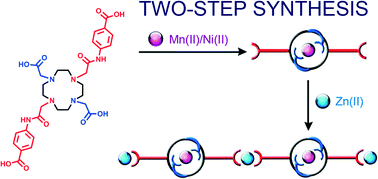
CrystEngComm, 2016,18, 4196-4204
https://doi.org/10.1039/C5CE02520F
Particle size effects in the kinetic trapping of a structurally-locked form of a flexible MOF
Controlling the particle size of a flexible metal–organic framework demonstrates that a 2D to 3D transformation gives a kinetically-trapped, structurally-locked form.
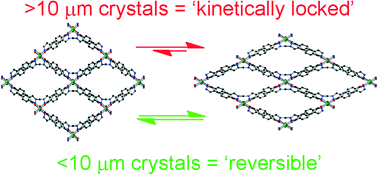
CrystEngComm, 2016,18, 4172-4179
https://doi.org/10.1039/C6CE00082G
Selective formation of Ag domains on MnO nanooctapods for potential dual imaging probes
MnO octapod–Ag heterodimers were formed through the selective growth of Ag domains on one of the high index surfaces of the MnO octapods. The MnO–Ag heterodimers exhibited multiple functions, including plasmon light scattering from the Ag domains and magnetic resonance from the MnO domains.
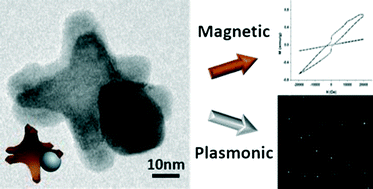
CrystEngComm, 2016,18, 4188-4195
https://doi.org/10.1039/C5CE02486B
Computational identification of organic porous molecular crystals
Geometry-based analysis, molecular simulations, and machine learning are used to rapidly identify and characterise porous organic molecular crystals in a large crystal structure database.
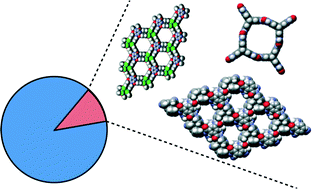
CrystEngComm, 2016,18, 4133-4141
https://doi.org/10.1039/C6CE00064A
Core–shell structured CeO2@MoS2 nanocomposites for high performance symmetric supercapacitors
Core–shell CeO2@MoS2 nanocomposites were successfully prepared via a wet chemistry strategy and they exhibited superior performance in a symmetric supercapacitor.
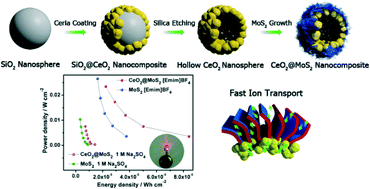
CrystEngComm, 2016,18, 4158-4164
https://doi.org/10.1039/C5CE02466H
Syntheses, structures, and magnetic properties of three new chain compounds based on a pentagonal bipyramidal Co(II) building block
Three homo-spin chain compounds constructed by pentagonal bipyramidal CoII units and linear organic bridges of different lengths were synthesized and characterized.
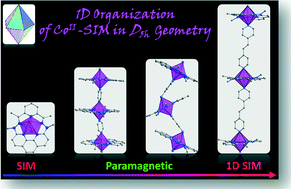
CrystEngComm, 2016,18, 4150-4157
https://doi.org/10.1039/C5CE02594J
Evaporable lanthanide single-ion magnet
Two thermally stable single-ion magnets containing a dysprosium ion with the ligand fod (1,1,1,2,2,3,3-heptafluoro-7,7-dimethyl-4,6-octadione) and bpy (2,2′-bipyridine) or phen (1,10-phenathroline) were synthesized, named 1Dy (Dyfod3bpy) and 2Dy (Dyfod3phen).
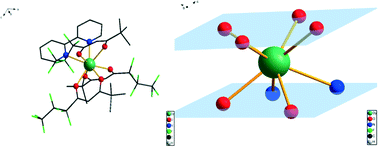
CrystEngComm, 2016,18, 4165-4171
https://doi.org/10.1039/C5CE02571K
Anion-controlled assembly of a series of heterometallic 3d–4f compounds with 0D cluster, 1D chain, 2D network and 3D frameworks
A series of heterometallic 3d–4f compounds have been synthesized through the reaction of Ni2+, Ln3+ and H4dcta ligand in the presence of different anions.
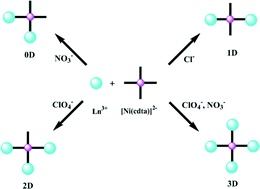
CrystEngComm, 2016,18, 4142-4149
https://doi.org/10.1039/C5CE02503F
Templated synthesis of diluted magnetic semiconductors using transition metal ion-doped metal–organic frameworks: the case of Co-doped ZnO
Co-doped ZnO diluted magnetic semiconductors were facilely fabricated through thermal decomposition of transition metal ion-doped metal–organic frameworks.
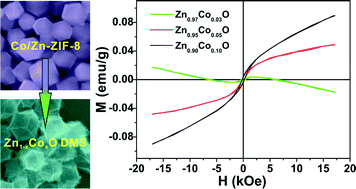
CrystEngComm, 2016,18, 4121-4126
https://doi.org/10.1039/C5CE02488A
Unique (3,9)-connected porous coordination polymers constructed by tripodal ligands with bent arms
Using tripodal ligands with bent arms, three new porous coordination polymers with novel 3D (3,9)-connected topologies have been constructed.

CrystEngComm, 2016,18, 4115-4120
https://doi.org/10.1039/C5CE02487K
Metal ion induced porous HKUST-1 nano/microcrystals with controllable morphology and size
HKUST-1 nano/microcrystals with controllable morphology and size were achieved by employing metal salts as additives.
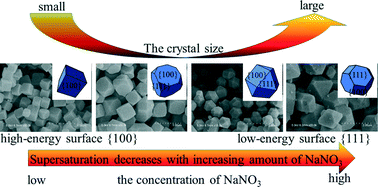
CrystEngComm, 2016,18, 4127-4132
https://doi.org/10.1039/C5CE02497H
Fabrication and absorption properties based on ZnO nanocomposites adjusted by length–diameter ratio of ZnO nanorods
A series of ZnO nanorods (NR) with different length to diameters have been synthesized. The relationship between the ratio of length to diameter and the absorption properties were also studied.
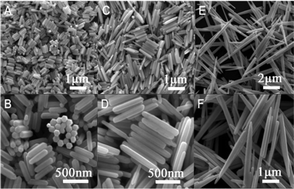
CrystEngComm, 2016,18, 4027-4031
https://doi.org/10.1039/C5CE02498F
Supramolecular tryptophan-zipper forms a tripeptide as a regular proton transporter
The tripeptide adopts a β-turn conformation and self-assembles to form a supramolecular tryptophan-zipper-like structure which acts as a regular proton transporter.
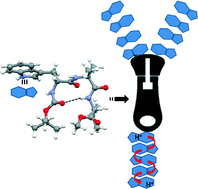
CrystEngComm, 2016,18, 4109-4114
https://doi.org/10.1039/C5CE02005K
Solvent-induced construction of two zinc metal–organic frameworks for highly selective detection of nitroaromatic explosives
Two three-dimensional metal–organic frameworks 1 and 2 based on p-terphenyl-3,4′′,5-tricarboxylic acid (H3TPT) were synthesized by controlling the solvent media. These two MOFs exhibit high efficiency for the recyclable detection of nitroaromatic compounds.
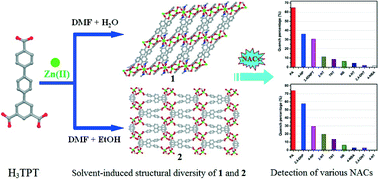
CrystEngComm, 2016,18, 4102-4108
https://doi.org/10.1039/C5CE02172C
Synthesis of the biocompatible and highly stable MIL-127(Fe): from large scale synthesis to particle size control
Controlled-sized crystals, from the nano to the microscale, of porous iron(III) 3,3′,5,5′-azobenzenetetracarboxylate MOF have been successfully prepared with very high space-time-yields using different synthetic routes.
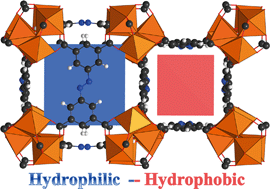
CrystEngComm, 2016,18, 4094-4101
https://doi.org/10.1039/C5CE01864A
Tunable gas adsorption properties of porous coordination polymers by modification of macrocyclic metallic tectons
We demonstrate crystal structure and gas adsorption can be tuned by the modification of macrocyclic metallic tectons through various aspects.
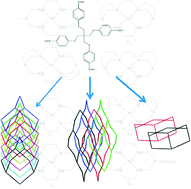
CrystEngComm, 2016,18, 4084-4093
https://doi.org/10.1039/C5CE01577D
Dynamic metal–organic frameworks: syntheses, characterizations, sorption studies and their hydrolytic inter-conversion
Two metal–organic frameworks show guest specific reversible, as well as irreversible, structural transformations leading from a 2D to 3D framework.
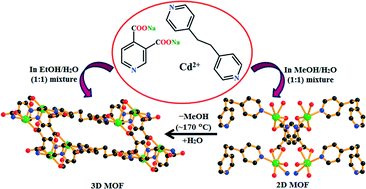
CrystEngComm, 2016,18, 4074-4083
https://doi.org/10.1039/C5CE01952D
Precursor-mediated synthesis of double-shelled V2O5 hollow nanospheres as cathode material for lithium-ion batteries
Hollow micro-/nanostructures have a wide range of applications in catalysis, rechargeable batteries, drug delivery, and gas sensors, as well as energy storage and conversion.
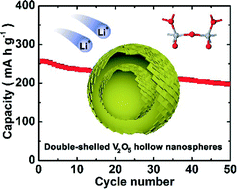
CrystEngComm, 2016,18, 4068-4073
https://doi.org/10.1039/C5CE01398D
4-Aminoquinaldine monohydrate polymorphism: prediction and impurity aided discovery of a difficult to access stable form
Crystal structure prediction studies of 4-aminoquinaldine monohydrate led, 80 years after its first synthesis, to the thermodynamically most stable form under conditions relevant for production and storage.
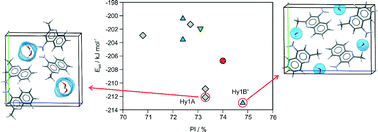
CrystEngComm, 2016,18, 4053-4067
https://doi.org/10.1039/C5CE01758K
Highly efficient photocatalysts by pyrolyzing a Zn–Ti heterometallic metal–organic framework
TiOx/C composites were prepared by pyrolyzing a Zn–Ti heterometallic MOF, which exhibit excellent photocatalytic activities toward photodegradation of an organic dye.
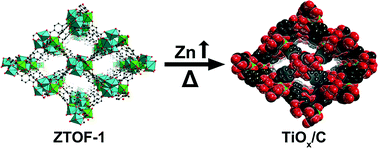
CrystEngComm, 2016,18, 4046-4052
https://doi.org/10.1039/C5CE01439E
About this collection
This CrystEngComm themed collection brings together contributions from researchers at the start of their independent career and those who have just entered the broad field of crystal engineering. With over 60 exciting papers covering topics ranging from the design of nanomaterials, organic frameworks, polymorphism of organic solids, to metal–organic frameworks (MOFs), contributed by authors across the globe, this issue truly celebrates the new talent working in the field of crystal engineering.